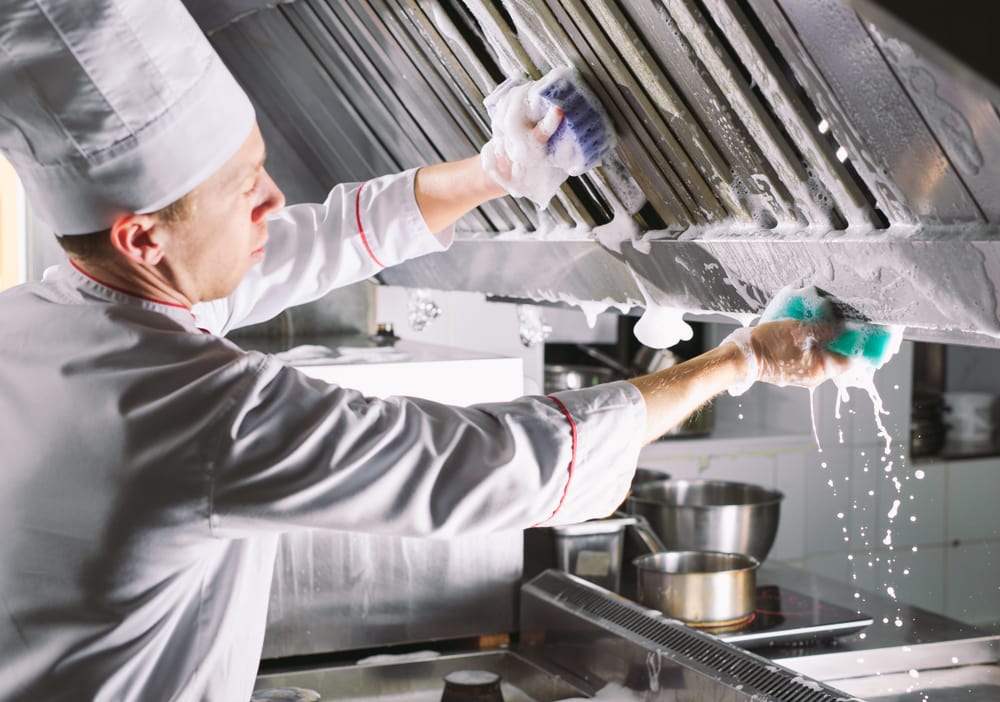Over time, the hood in a kitchen exhaust system accumulates grease particulate from food preparation, clogging the system. In addition to reducing the performance of the fan, it makes for a smoky, uncomfortable, and unsanitary working environment with poor air quality. These conditions can open your business up to fines or closures if you are found to be in violation of local or national ordinances. If left unchecked, that greasy building has the potential to catch fire and destroy your equipment, facility, and even your business.
The best way to avoid a safety hazard is to work with a professional hood cleaning company and schedule regular service visits. Learn more about suggested cleaning intervals for commercial hoods and the hood-cleaning process.

Recommended Commercial Hood Cleaning Frequency
According to NFPA 96-12.6, cooking establishments should regularly have certified professionals in for kitchen hood cleaning, with the required scheduling based on the equipment, the volume and types of food the kitchen prepares, and other factors. The recommended cleaning frequencies are:
- Kitchens using solid fuel preparation: Every month
- High-grease or fast-food restaurants: Every month
- High-volume or 24/7 kitchens: Every three months
- General restaurants or cafeterias: Every two or three months
- Charbroiler, woodstove, or wok food preparation: Every three months
- Medium-volume kitchens and those using less grease: Every six months
- Low-volume or seasonal kitchens: Once a year
However, these are just recommended frequencies. In some cases, you may need to clean sooner, particularly if you notice the following:
- Damaged or dented components, or those making unusual sounds
- Difficulty accessing and opening the device
- High temperatures from system exhaustion
- Unpleasant odors
- Visible grease buildup or stains on either system components or the rooftop
Commercial Hood Cleaning Process
Trained professionals accomplish commercial cleaning through these important steps:
Initial Inspection
The inspection stage involves a technician or cleaning team checking the exhaust system for any specific component or functionality concerns requiring particular attention.
System Shutdown
As a safety precaution, the technician will turn off the entire system as well as any gas valves and pilot lights before beginning the cleaning process. This prevents potential damage to both the system and any cleaning tools, and safeguards the technician and the facility from potential fires.
Kitchen Preparation
With it being an untidy process, the technician will lay down coverings to protect nearby surfaces, floors, or appliances. They will also remove the system baffle filters and prep the funnels to collect the dirt and grease.
Cleaning
The cleaning process will take place both in the kitchen and on the roof. A technician will climb to the roof, apply a degreaser to system components, and clean them with hot water. In the kitchen itself, the technician will ensure that the washed-down wastewater flows through the funnel and into a collection container for less mess. They also use the degreaser on the baffle filters with a hot-water rinse. For any problem areas with caked debris, the technician will manually scrape the surface to loosen residue and remaining grease. Once done, they will again spray a degreaser and rinse with hot water until they have removed all debris.
At this point, the technician will address the kitchen hood itself, utilizing the same applications of degreaser spray and hot water or pressure-washing until the system is finally clean. To end the process, your technician will remove the hood to dry and polish it.
Cleanup and Final Inspection
After reinstalling the baffle filters, the technician or team will clean up any excess water, remove tarps, and otherwise leave the kitchen as they found it. They will test the exhaust system to ensure the fan is working as it should and any issues from the initial inspection are resolved. Lastly, they will apply a certification sticker with the date and the system’s compliance to Baltimore or local fire codes, and complete a report to document the cleaning, along with any suggested preventative or future maintenance steps.
Schedule a Cleaning with IMC
Maintaining a regular cleaning schedule for your commercial hood system with a certified hood cleaning service is essential for safe operations and air quality, as well as long-lasting kitchen equipment. If you are looking for kitchen exhaust cleaning or restaurant hood cleaning in Baltimore, Maryland, the team at Interior Maintenance Company, Inc. is here to help.
In business as a family-owned company since 1973 and cleaning kitchen hoods in the mid-Atlantic region since 1998, IMC is a leading kitchen hood cleaning service and facility maintenance company offering kitchen exhaust cleaning in Baltimore, Maryland, and the surrounding areas. Our highly trained team has the experience and extensive knowledge of local and national regulations to support your business’ safe operations with reliable service and affordable prices.
Contact us today for more information on our kitchen hood services, or request a quote to set up a cleaning.
